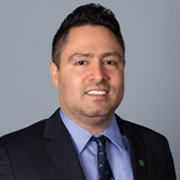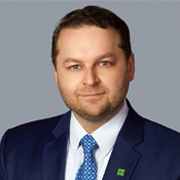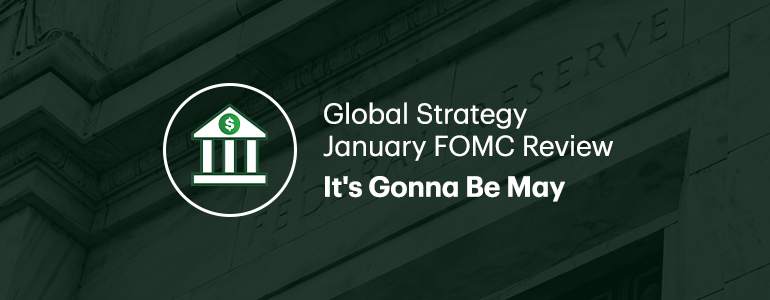New Fed Call: Curb Your Enthusiasm
By: Oscar Muñoz, Gennadiy Goldberg, Molly McGown
Mar. 01, 2024 - 7 minutes
So You're Telling Me There's a Chance?
A stubbornly resilient U.S. consumer and a swifter than expected deceleration in core PCE inflation have shifted the winds of the U.S. economic outlook at the start of 2024. The much-improved inflation profile this year will likely allow the Fed to methodically start taking its foot off the monetary policy brake ahead of a deterioration in the labor market and consumer spending — a key policy shift that played against our recession call.
In effect, we expected the Fed to be reactive rather than proactive when easing rates this year. We were of the view that the Fed would begin to cut rates when it was clear that the "higher for longer" policy stance was increasingly denting economic growth. Instead, the Fed will likely act pre-emptively when implementing its first rate cuts, responding to a more favorable inflation outlook rather than to worsening economic conditions. This is a significant change.
Given the shifts in data and the Fed's likely bent to ease pre-emptively, we are now assuming a soft landing scenario as the base case for the U.S. economy. In this context, we are now looking for the FOMC to cut rates by five times this year starting in May, with the Fed funds rate ending the year at 4.00%-4.25%. We continue to expect the Fed will reach its neutral policy stance by the end of 2025, with the policy rate being eased another five times to 2.75%-3.00%. On the QT front, we continue to expect the Fed to announce a preliminary plan on QT tapering in March and begin tapering QT at the May FOMC meeting.
Why Would the Fed Ease Policy Amid Still Solid Growth?
Fed officials are no longer convinced that they need to overly lean against economic activity in order to guide inflation back to target. The Fed has moved quite notably away from its 2022 stance when Chair Powell warned that high policy rates would "also bring some pain to households and businesses" and that "[t]hese are the unfortunate costs of reducing inflation." Back then, the Fed was forecasting the unemployment rate to jump to 4.4% in 2023 and to stay at that level through end-2024 — a move typically consistent with recession-triggering conditions in the labor market.
Fast forward to the January FOMC meeting when Powell underscored that strong growth is no longer an issue in itself: "whereas a year ago... we were thinking that we needed to see some softening in economic activity—that hasn’t been the case...We don’t look at it as a problem. I think, at this point, we want to see strong growth. We want to see a strong labor market. We’re not looking for a weaker labor market." The Fed is now projecting the unemployment rate to settle at 4.1% and to stay there through the forecast horizon.
It's All About Real Rates
The Fed broadly agrees that the policy stance is currently very restrictive. Policymakers for the most part have also acknowledged that the bulk of policy tightening is yet to be fully transmitted into the real economy. Mending supply-side factors, including the easing of post-Covid disruptions, have likely masked the brunt of the impact from tighter monetary policy. Policymakers are cognizant that the macro picture might quickly revert as those factors normalize.
"What’s happening, though, is, the supply side has been recovering in the middle of this. So that, that won’t go on forever... You’re getting, you know, more activity because of the—of labor market healing and supply chains healing. So I think the question is, when that peters out... the restriction will show up probably more, more sharply."
— Jerome Powell, Chair of the Federal Reserve
Those comments from Chair Powell highlight the Fed's wariness about overdoing policy tightening as it continues to embrace the possibility of a soft landing amid rapid progress on inflation. The Fed is aware that monetary policy can turn even tighter as inflation continues to steadily lose momentum this year.
A still-strong growth profile is currently allowing the Fed to be patient as it seeks to gather further confirmation that core price disinflation is not a temporary, goods-driven event. However, we think that at the first signs of clear growth deceleration the Fed will react more swiftly toward loosening the policy restraint.
While the Fed is currently projecting a conservative path lower in policy rates under a scenario of a gradual GDP growth adjustment, we expect a more visible move toward below-trend growth over Q2-Q3 2024 as tight monetary policy weighs more visibly on already loosening labor market conditions. In this scenario, we expect the Fed to initially carry on with its plan of careful pre-emptive easing starting in May — with the FOMC likely signaling rate cuts at every other meeting. However, mounting evidence of growth deceleration will likely force the Fed to implement cuts at every meeting starting in July. Even under our scenario of five cuts this year, the monetary policy stance will remain notably restrictive — only modestly less punishing than what Fed officials are currently projecting.
Indeed, while the Fed would be easing rates in nominal terms, policy will likely remain very restrictive in real terms through the end of the year. This is why we believe that the Fed can begin easing for inflation reasons alone as it aims to maintain the current degree of policy restrictiveness. By postponing its decision to ease rates, the Fed would effectively be tightening their real policy stance.
Risks to Our View
Our more dovish policy view when compared to the Fed and the market's current pricing hinges on both our expectation for continued moderation in core inflation and below-trend growth dynamics. There are lingering risks that could derail our view, particularly given ample post-Covid uncertainties that may impact the structural foundations of the economy. These include a permanent move higher in productivity growth, a higher r*, or more limited efficacy of tighter monetary policy, among others.
Depending on how these known unknowns evolve, we could see either a Fed that eases rates more swiftly than we currently anticipate or be even more conservative in returning policy back to neutral. In the table below we express how different scenarios might affect the Fed's policy decisions and what that in turn means for the rates market. We are now assigning 60% odds for a soft landing and 35% odds to hard landing.
Softer Landing the Most Likely Outcome in 2024
Updating Treasury Yield Forecasts
Given the update to our Fed call, we revise our rates forecasts higher. There are a few of changes to our forecasts worth noting:
- Year-end 2024 10y level: Given our expectation for a more gradual pace of Fed rate cuts, we now expect 10y rates to finish the year at 3.45%. This is still below market expectations and forwards given our view that the Fed will deliver more cuts than the market is currently pricing. While we see more downside in yields, this downside may be realized more gradually than we previously expected.
- Timing of trough in rates pushed out: We previously expected the trough in rates in Q1 2025, but now look for the trough in rates to occur in Q3 2025 as rates get closer to neutral at 3%. In addition, given our view that the pace of cuts in 2025 should slow, there is a risk that rates remain near trough levels for some time.
- Curve steepening more gradually: With the Fed still likely to start cuts in May, we still expect the curve to begin steepening in coming months but look for steepening momentum to be more gradual. We now look for the peak in curve steepness to occur around mid-2025 and expect the curve to hover around those steeper levels for some time.
Subscribing clients can read the full report via the TD One Portal










